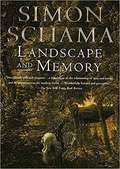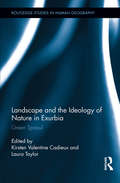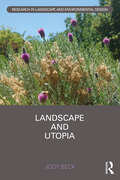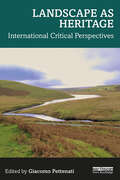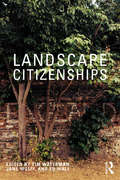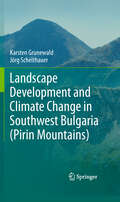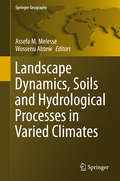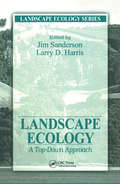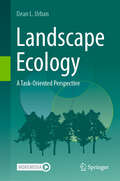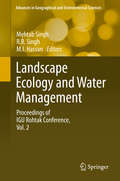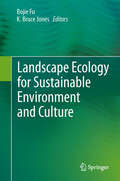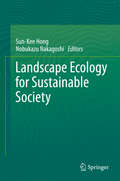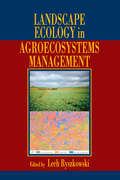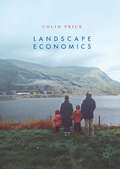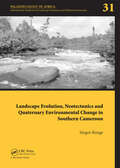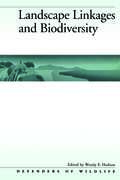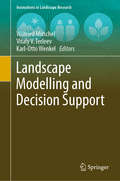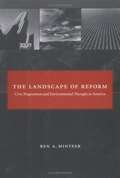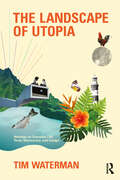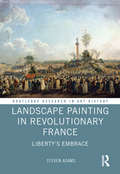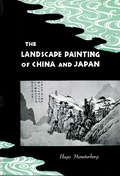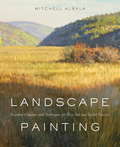- Table View
- List View
Landscape And Memory
by Simon SchamaIn Landscape and Memory, award-winning author Simon Schama ranges over continents and centuries to reveal the psychic claims that human beings have made on nature. He tells of the Nazi cult of the primeval German forest; the play of Christian and pagan myth in Bernini's Fountain of the Four Rivers; and the duel between a monumental sculptor and a feminist gadfly on the slopes of Mount Rushmore. The result is a triumphant work of history, naturalism, mythology, and art, as encyclopedic as The Golden Bough and as irresistibly readable as Schama's own Citizens.
Landscape and Nature in Scandinavian Art (Routledge Research in Art History)
by MaryClaire PappasThis edited volume foregrounds new and vital scholarship shaping Scandinavian art historical research on the representations of the natural world.Contributors deconstruct the interlinking of people and land through critical readings of the Scandinavian representation of nature, bringing to the fore how the traditional focus on the landscape as a manifestation of temperament has tended to obfuscate critical approaches to the representation of the landscape. Making interdisciplinary connections, this volume redresses the imbalance in scholarship on the region that often emphasizes teleological national narratives and instead situates encounters with nature and the landscape in relationship to more interdisciplinary perspectives. Each chapter serves as a specific case study on topics ranging from circumpolar exploration and colonial practices, deconstructing National Romanticism myths, and contemporary artistic responses to the history of the politics of land.The book will be of interest to scholars working in art history, visual culture, nature studies, and environmental history.
Landscape and the Ideology of Nature in Exurbia: Green Sprawl (Routledge Studies in Human Geography #39)
by Laura Taylor Kirsten Valentine CadieuxThis book explores the role of the ideology of nature in producing urban and exurban sprawl. It examines the ironies of residential development on the metropolitan fringe, where the search for “nature” brings residents deeper into the world from which they are imagining their escape—of Federal Express, technologically mediated communications, global supply chains, and the anonymity of the global marketplace—and where many of the central features of exurbia—very low-density residential land use, monster homes, and conversion of forested or rural land for housing—contribute to the very problems that the social and environmental aesthetic of exurbia attempts to avoid. The volume shows how this contradiction—to live in the green landscape, and to protect the green landscape from urbanization—gets caught up and represented in the ideology of nature, and how this ideology, in turn, constitutes and is constituted by the landscapes being urbanized.
Landscape and the Spaces of Metaphor in Ancient Literary Theory and Criticism
by Nancy WormanThis study explores a previously uncharted area of ancient literary theory and criticism: the ancient landscapes (such as the Ilissus river in Athens and Mount Helicon) that generate metaphors for distinguishing styles, which dovetail with ancient conceptions of metaphor as itself spatial and mobile. Ancient writers most often coordinate stylistic features with country settings, where authoritative performers such as Muses, poets, and eventually critics or theorists view, appropriate, and emulate their bounties (for example springs, flowers, rivers, paths). These spaces of metaphor and their elaborations provide poets and critics with a vivid means of distinguishing among styles and an influential vocabulary. Together these figurative terrains shape critical and theoretical discussions in Greece and beyond. Since this discourse has a remarkably wide reach, the book is broad in scope, ranging from archaic Greek poetry through Roman oratory and 'Longinus' to the reception of critical imagery in Proust and Derrida.
Landscape and Utopia (Routledge Research in Landscape and Environmental Design)
by Jody BeckThis book examines three landmark utopian visions central to 20th century landscape architectural, planning, and architectural theory. The period between the 1890s and the 1940s was a fertile time for utopian thinking. Significant geographic shifts of large populations; radically altered relations between capital and labor; rapid technological developments; large investments in transportation and energy infrastructure; and repetitive economic disruptions motivated many individuals to wholly reimagine society – including the connections between social relations and the built environment. Landscape and Utopia examines the role of landscapes in the political imaginations of the Garden City, the Radiant City, and Broadacre City. Each project uses landscapes to propose a reconstruction of the relationships between land, labor, and capital but - while the projects are well-known – the role played by landscapes has been largely left unexamined. Similarly, the radical anti-capitalism that underpinned each project has similarly been, for the most part, left out of contemporary discussions. This book sets these projects within a historical and philosophical context and opens a discussion on the role of landscapes in society today. This book will be a must-read for instructors, students, and researchers of the history and theory of landscape architecture, planning, and architecture as well as utopian studies, cultural and social history, and environmental theory.
Landscape as Heritage: International Critical Perspectives
by Giacomo PettenatiThis edited book provides a broad collection of current critical reflections on heritage-making processes involving landscapes, positioning itself at the intersection of landscape and heritage studies. Featuring an international range of contributions from researchers, academics, activists, and professionals, the book aims to bridge the gap between research and practice and to nourish an interdisciplinary debate spanning the fields of geography, anthropology, landscape and heritage studies, planning, conservation, and ecology. It provokes critical enquiry about the challenges between heritage-making processes and global issues, such as sustainability, economic inequalities, social cohesion, and conflict, involving voices and perspectives from different regions of the world. Case studies in Italy, Portugal, Spain, Slovenia, the Netherlands, Turkey, the UK, Columbia, Brazil, New Zealand, and Afghanistan highlight different approaches, values, and models of governance. This interdisciplinary book will appeal to researchers, academics, practitioners, and every landscape citizen interested in heritage studies, cultural landscapes, conservation, geography, and planning.
Landscape Citizenships: Ecological, Watershed and Bioregional Citizenships
by Tim WatermanLandscape Citizenships, featuring work by academics from North America, Europe, and the Middle East, extends the growing body of thought and research in landscape democracy and landscape justice. Landscape, as a milieu of situated everyday practice in which people make places and places make people in an inextricable relation, is proving a powerful concept for conceiving of politics and citizenships as lived, dialogic, and emplaced. Grounded in discourses of ecological, environmental, watershed, and bioregional citizenships, this edited collection evaluates belonging through the idea of landscape as landship which describes substantive, mutually constitutive relations between people and place. With a strong international focus across 14 chapters, it delves into key topics such as marginalization, indigeneity, globalization, politics, and the environment, before finishing with an epilogue written by Kenneth R. Olwig. This volume will appeal to scholars and activists working in citizenship studies, migration, landscape studies, landscape architecture, ecocriticism, and the many disciplines which converge around these topics, from design to geography, anthropology, politics, and much more.
Landscape Development and Climate Change in Southwest Bulgaria (Pirin Mountains)
by Karsten Grunewald Jörg ScheithauerLandscape Development and Climate Change in Southwest Bulgaria aims to address some of the current limitations in our understanding of past Balkan climate and environment. High mountains and their ecosystems offer an outstanding opportunity for studies on the impact of climate change. The Balkan Mountains in Southeast Europe, situated at the transition between temperate and Mediterranean climate, are considered as very sensitive to historical and current global changes. The geoarchives lake sediment, peat and soil, long living trees and glaciers have been used to reconstruct the climatically-driven change of forest and treeline during the Holocene and the younger past. These processes are interrelated with complex ecological changes, as for example the seasonality of climate parameters. The landscape research approach with the analyses through multi-palaeo-geoecological proxies is new for the Balkans.
Landscape Dynamics, Soils and Hydrological Processes in Varied Climates
by Assefa M. Melesse Wossenu AbtewThe book presents the processes governing the dynamics of landscapes, soils and sediments, water and energy under different climatic regions using studies conducted in varied climatic zones including arid, semi-arid, humid and wet regions. The spatiotemporal availability of the processes and fluxes and their linkage to the environment, land, soil and water management are presented at various scales. Spatial scales including laboratory, field, watershed, river basin and regions are represented. The effect of tillage operations and land management on soil physical characteristics and soil moisture is discussed. The book has 35 chapters in seven sections: 1) Landscape and Land Cover Dynamics, 2) Rainfall-Runoff Processes, 3) Floods and Hydrological Processes 4) Groundwater Flow and Aquifer Management, 5) Sediment Dynamics and Soil Management, 6) Climate change impact on vegetation, sediment and water dynamics, and 7) Water and Watershed Management.
Landscape Ecology: A Top Down Approach (Landscape Ecology Series)
by Jim Sanderson Larry D. HarrisLandscape Ecology - a rapidly growing science - quantifies the ways ecosystems interact. It establishes links between activities in one region and repercussions in another. Landscape Ecology: A Top-Down Approach serves as a general introduction to this emerging area of study.In this book the authors take a "top down" approach. They believe that
Landscape Ecology: A Task-Oriented Perspective
by Dean L UrbanThis is methods/tools textbook that covers the fundamental tasks in research and management at the landscape scale. It brings together tools from a range of disciplines and presents them in a natural workflow that a practitioner can appreciate. Alternative texts cover a narrower range of topics and/or present the information without reference to a natural workflow. The book begins with 2 fundamental applications that introduce the scope and challenges of working at the landscape scales (sampling design and species distribution modeling). These motivate several chapters that ‘digress’ to cover the primary tools that ecologists use to work with multivariate and spatial data. The book then returns to applications including site prioritization, interpreting (and forecasting) landscape change, and integrated assessment. The tasks themselves follow a logical workflow of collecting and analyzing data, applying the analyses to management decisions, and interpreting the outcomes of these decisions in an integrated framework. This book stems from two graduate-level courses in Landscape Ecology taught at the Nicholas School of the Environment at Duke University. The subject has evolved over time, from a concepts-based overview of what landscape ecology is, to a more applied practicum on how one does landscape ecology. As landscape ecology has matured as a discipline, its perspectives on spatial heterogeneity and scale have begun to permeate into a wide range of other fields including conservation biology, ecosystem management, and ecological restoration. Thus, this textbook will bring students from diverse backgrounds to a common level of understanding and will prepare them with the practical knowledge for a career in conservation and ecosystem management.
Landscape Ecology And Geographical Information Systems
by Roy Haines-Young David R.Green Steven CousinsThe landscape we see and live in is an important part or our everyday lives, be they urban or rural. Environmental concern has grown in recent years, as a result of public awareness of the detrimental impact industry, transport and tourism can have on the ecosystem. This book examines the role of the new technologies of geographical information sys
Landscape Ecology and Water Management
by Mehtab Singh R. B. Singh M. I. HassanThe over-exploitation of important earth resources such as land and water has led to a number of environment-related problems the world over. At the same time, land-use change caused by various human activities has led to extinction of many plant and animal habitats and species. In this context, the relevance of biodiversity for human survival is becoming a major international political issue as scientific evidence builds on the global health implications of biodiversity loss. These issues are closely linked with the issue of climate change, as many of the health risks due to climate change are associated with rapid degradation of biodiversity. This present work focuses on holistic natural resource-based spatio-temporal planning, development and management and considers them as essential to save the degraded ecosystem for sustainable resource management. Contributions are compiled in two volumes: 1. Climate Change and Biodiversity and 2. Landscape Ecology and Water Management. Geoinformatics along with its tools such as remote sensing and Geographical Information Systems (GIS) have been used in assessing the results of various environmental problems both physical and social. These volumes will be useful for geographers, geoscientists, hydrologists, landscape ecologists, environmentalists, engineers, planners and policy makers.
Landscape Ecology for Sustainable Environment and Culture
by Bojie Fu Bruce Jones KClimate change and the pressures of escalating human demands on the environment have had increasing impacts on landscapes across the world. In this book, world-class scholars discuss current and pressing issues regarding the landscape, landscape ecology, social and economic development, and adaptive management. Topics include the interaction between landscapes and ecological processes, landscape modeling, the application of landscape ecology in understanding cultural landscapes, biodiversity, climate change, landscape services, landscape planning, and adaptive management to provide a comprehensive view that allows readers to form their own opinions. Professor Bojie Fu is an Academician of Chinese Academy of Sciences and Chair of scientific committee at the Research Center for Eco-Environmental Sciences, Chinese Academy of Sciences, Beijing, China. Professor K. Bruce Jones is the Executive Director for Earth and Ecosystem Sciences Division at Desert Research Institute, University of Nevada, Las Vegas, USA.
Landscape Ecology for Sustainable Society
by Sun-Kee Hong Nobukazu NakagoshiThe research category of the landscape ecology, which researches the structure, functions, and the spatio-temporal changes of the ecological landscapes, has now been contributing to the human life and the shifts of the socio-economic paradigm. Global warming has been influencing the universal life patterns of the mankind which have been maintained in the past several hundreds of years. And it has been having the influences on the international social problems and economic problems. Although the diverse plans for adapting to the climate changes have been the topics of the conservations among the ecologists internationally, it is the reality that the speed of the changes of the environment has been quicker than the time it takes to complete the solutions. In order to maintain the sustainable earth and the sustainable society, the role of the landscape ecology has been coming to the fore. Especially, the theories and the methodologies of the landscape ecology have been applied to the multidisciplinary researches by going beyond the research category of ecology, including the maximization of the efficiencies of the land spaces, the management of the ecological space (habitats) in which the biological diversity can be maintained, the utilization of the resources that are absolutely needed by the human beings (Here, it is compressed to water, energy, and food), etc. and until reaching the human society. It is considered that, to that extent, the utilizations and the applications of the landscape ecology are very much needed for the diagnoses and the evaluations of the global environmental problems which have been proceeded with rapidly in the modernity.This book is not comprised of any general remarks that explain the theories and the methods of the landscape ecology. Already, based on the basic theories of the landscape ecology, the writers have conducted the investigations on the farm villages, the cities, and the coastal ecosystems. And, through the space analyses and interpretations, the structure and functions of the landscapes were analyzed. Of course, in this book, too, the diverse ecosystems and the landscape ecological methodologies regarding the land use have been presented. However, the core of this book focuses more on what role the landscape ecology must play for the materialization of a sustainable society in the future. At the farm villages, the sustainable agriculture will be presented, and, at the cities, the discussions on the green networks and the energies will be proceeded with. Also, regarding the coasts and the seas, a thesis on the safety of the life zones of the residents adjacent to the sea and on the conservation of the island ecosystems will be presented. The sustainable society is a system that is formed by having the sustainable development as a basis. It is considered to be one aspect within a kind of a sustainable process with regard to which the natural world and the human world coexist and are in a symbiotic relationship harmoniously. In order to maintain the biodiversity, the reasonable adjustments of the human activities, like the use of the resources, are absolutely needed. Without the biological resources, the cultural diversity of the human beings, too, cannot exist. Consequentially, recently and internationally, there are a lot of the case examples that express the biocultural diversity by linking the biological diversity with the cultural diversity. In this book, the role of the landscape ecology as an academic link which can connect the two possible, if possible, is highly expected. It is, indeed, the biocultural landscape. It can be said that this concept, also, is the interconnection of the multidisciplinary spaces that must be dealt with in the modern landscape ecology. Through this book, it is intended to present a new directionality which can contribute to the sustainable society at the same time as the organization of the theories and the methods of the landscape ecology.
Landscape Ecology in Agroecosystems Management
by Lech RyszkowskiSuccessful management of agricultural landscapes depends on the recognition of the relationships between the processes and the structures that maintain the system. The rapidly growing science of Landscape Ecology quantifies the ways these ecosystems interact and establishes a link between the activities in one region and repercussions in another. A
Landscape Economics
by Colin PriceThis revised and expanded edition of Colin Price's seminal publication provides a richly comprehensive and up-to-date coverage of landscape economics, a subject which has until now been addressed only in limited aspects. Although much of the book's discussion is based upon natural resources and environmental economics, the author presents a wide and integrative view, drawing from aesthetic, psychological, social and political perspectives and applying a critical use of economic concepts and challenges to different schools of thought on the landscape. This new edition includes new ideas and critiques on environmental valuation; more focused critiques of stated preference methods, political alternatives to economic valuation, and of the rationale of discounting future values; and, new evaluative techniques, particularly price premia for products with a landscape provenance. For those interested in the theoretical aspects of aesthetic valuation, and for those who seek solutions to practical problems of aesthetic conservation, amelioration and enhancement, this new edition gives an overview of evaluative techniques, of their potential problems and of possible solutions. The updates are a major contribution to the growing literature in the field.
Landscape Evolution, Neotectonics and Quaternary Environmental Change in Southern Cameroon: Palaeoecology of Africa Vol. 31, An International Yearbook of Landscape Evolution and Palaeoenvironments (Palaeoecology of Africa)
by Jürgen RungeFounded in 1966, the internationally recognized and acclaimed SeriesPalaeoecology of Africa publishes interdisciplinary scientific papers on landscape evolution and on former environments of the African continent. Beginning with topics such as changes in climate and vegetation cover, the papers expand horizons and interconnections to various typ
Landscape Linkages and Biodiversity: Policies For A Sustainable Future
by Larry Harris Michael E. Soulé J. Michael Scott Wendy E. Hudson Blair Csuti Keith HayIn Landscape Linkages and Biodiversity experts explain biological diversity conservation, focusing on the need for protecting large areas of the most diverse ecosystems, and connecting those ecosystems with land corridors to allow species to move among them more easily.
Landscape Modelling and Decision Support (Innovations in Landscape Research)
by Wilfried Mirschel Vitaly V. Terleev Karl-Otto WenkelThis book contributes to a deeper understanding of landscape and regional modelling in general, and its broad range of facets with respect to various landscape parameters. It presents model approaches for a number of ecological and socio-economic landscape indicators, and also describes spatial decision support systems (DSS), frameworks, and model-based tools, which are prerequisites for deriving sustainable decision and solution strategies for the protection of comprehensively functioning landscapes. While it mainly focuses on the latest research findings in regional modelling and DSS in Europe, it also highlights the work of scientists from Russia. The book is intended for landscape modellers, scientists from various fields of landscape research, university teaching staff, and experts in landscape planning and management, landscape conservation and landscape policy.
The Landscape of Reform: Civic Pragmatism and Environmental Thought in America
by Ben A. MinteerMinteer offers a fresh and provocative reading of the intellectual foundations of American environmentalism, focusing on the work and legacy of four important conservation and planning thinkers in the first half of the twentieth century.
The Landscape of Utopia: Writings on Everyday Life, Taste, Democracy, and Design
by Tim WatermanA collection of short interludes, think pieces, and critical essays on landscape, utopia, philosophy, culture, and food, all written in a highly original and engaging style by academic and theorist Tim Waterman. Exploring power and democracy, and their shaping of public space and public life, taste, etiquette, belief and ritual, and foodways in community and civic life, the book provides a much-needed critical approach to landscape imaginaries. It discusses landscape in its broadest sense, as a descriptor of the relationship between people and place that occurs everywhere on land, from cities to countryside, suburb to wilderness. With over fifty black and white illustrations interspersing the twenty-six chapters, this is a book for professionals, academics, and students to dive into and spark discussion on new modes of thinking in the wake of unfolding global crises, such as COVID-19, climate change, fascism 2.0, and beyond.
Landscape Painting in Revolutionary France: Liberty's Embrace (Routledge Research in Art History)
by Steven AdamsThe French Revolution had a marked impact on the ways in which citizens saw the newly liberated spaces in which they now lived. Painting, gardening, cinematic displays of landscape, travel guides, public festivals, and tales of space flight and devilabduction each shaped citizens’ understanding of space. Through an exploration of landscape painting over some 40 years, Steven Adams examines the work of artists, critics and contemporary observers who have largely escaped art historical attention to show the importance of landscape as a means of crystallising national identity in a period of unprecedented political and social change.
The Landscape Painting of China and Japan
by Hugo MunsterbergThe Landscape Painting of China and Japan presents for the first time in English a full and lucid account of the remarkable art form which, as a distinct tradition in Oriental art, has come to be universally recognized as one of the greatest in the world. <P><P>The author points out how essential it is to an understanding of the Orient when he says: "In China alone, landscape painting has religious as well as philosophical significance...and in consequence is one of the great manifestations of the human spirit, as well as the most remarkable creation of the Chinese artistic genius." And it was this same artistic tradition which, brought to Japan, was transmuted by the intense Japanese love of nature into paintings that "for sheer beauty of color and design have few equals," leading at last to the simplicity and grandeur of the uniquely Japanese woodblock print.Writing for scholar and layman alike, the author carefully traces the evolution of the art throughout its long history, discusses the major artistic personalities against their cultural backgrounds, and systematically describes the development and forms of the landscape. The text is thoroughly illustrated with over a hundred carefully selected plates and a colored frontispiece.
Landscape Painting (PE): Essential Concepts and Techniques for Plein Air and Studio Practice
by Mitchell AlbalaBecause nature is so expansive and complex, so varied in its range of light, landscape painters often have to look further and more deeply to find form and structure, value patterns, and an organized arrangement of shapes. In Landscape Painting, Mitchell Albala shares his concepts and practices for translating nature's grandeur, complexity, and color dynamics into convincing representations of space and light. Concise, practical, and inspirational, Landscape Painting focuses on the greatest challenges for the landscape artist, such as: • Simplification and Massing: Learn to reduce nature's complexity by looking beneath the surface of a subject to discover the form's basic masses and shapes.• Color and Light: Explore color theory as it specifically applies to the landscape, and learn the various strategies painters use to capture the illusion of natural light.• Selection and Composition: Learn to select wisely from nature's vast panorama. Albala shows you the essential cues to look for and how to find the most promising subject from a world of possibilities. The lessons in Landscape Painting—based on observation rather than imitation and applicable to both plein air and studio practice—are accompanied by painting examples, demonstrations, photographs, and diagrams. Illustrations draw from the work of more than 40 contemporary artists and such masters of landscape painting as John Constable, Sanford Gifford, and Claude Monet. Based on Albala's 25 years of experience and the proven methods taught at his successful plein air workshops, this in-depth guide to all aspects of landscape painting is a must-have for anyone getting started in the genre, as well as more experienced practitioners who want to hone their skills or learn new perspectives.
